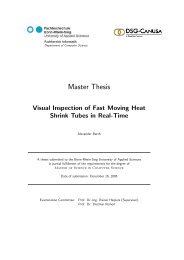Master Thesis - Hochschule Bonn-Rhein-Sieg
Master Thesis - Hochschule Bonn-Rhein-Sieg
Master Thesis - Hochschule Bonn-Rhein-Sieg
Create successful ePaper yourself
Turn your PDF publications into a flip-book with our unique Google optimized e-Paper software.
5. Algorithms <strong>Master</strong> <strong>Thesis</strong> Björn Ostermann page 61 of 126<br />
used _ range � max_brightness<br />
� min_brightness<br />
complete _ range<br />
scaling _ factor �<br />
used _ range<br />
new_<br />
brightness � scaling _ factor �<br />
Equation 3: Scaling algorithm<br />
a) b)<br />
Number of Pixels<br />
Offset<br />
Used Range<br />
Complete Range<br />
Illumination<br />
c) d)<br />
Number of Pixels<br />
Offset<br />
Used Range<br />
Complete Range<br />
Illumination<br />
�brightness � min_brightness�<br />
Figure 38: Scaling algorithm a) to b) with a small used range<br />
and c) to d) with a large used range<br />
Number of Pixels<br />
Number of Pixels<br />
Illumination<br />
Illumination<br />
This pixel distribution of more than one information cluster is not a special, but a normal case,<br />
especially in industrial environments where lowly reflecting materials like cloth meet highly reflective<br />
materials like metals. In the case of the used workspace the mounting of the camera, visible in the<br />
camera’s image, has a high reflectivity, whereas the floor has a very low one. Thus clusters at both<br />
ends of the intensity range are always present.<br />
This problem can be avoided by using the histogram equalization, which is described in Figure 39,<br />
starting with the real distribution in Figure 39a and ending with the resulting distribution in Figure<br />
39e. In the real distribution, there are two regions visible in which the majority of the pixels’ values<br />
are located.














